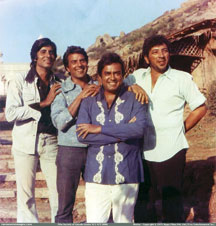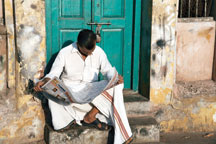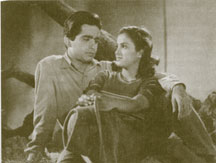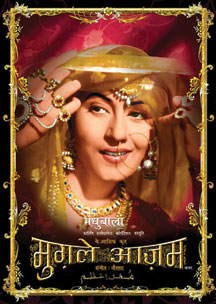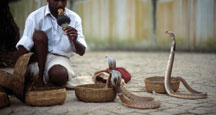Magazine
Aye Mere Bichhade Chaman

Do you pine sometimes for the sounds, the images, the rhythms and the media constructions of your past?
|
It is hard to describe outside of your own head what it is like to listen to Talat Mehmood on your iPod, walking anywhere in the U.S. The sudden smile on your face, the intense appreciation of the sound, the voice and the thankful wonders of modern technology. That sudden gesture of “Wah, wah!” at one of his subtle treatments of emotion in a gazal emerges and you catch yourself in a different place than the one in your imagination. The “waking up” is hard to do. It is hard to be an immigrant, to be somewhere else all the time.
You walk into a grocery store, or an audio-video store and realize that the sections for the “oldies” are getting smaller. There is this new crop of stars, with muscles and gyrating hips that you cannot relate to. Maybe your daughter or son or someone else can, but not you. You watch these movies and listen to these songs and you realize things are no match for what used to be. How stale and vapid this world is, you think. And occasionally, you have this argument with someone around you about how good the days were when you were young. And, if you are honest, you tell them how they missed the real stuff from the world that is now gone. This feeling of being lost, of having lost the things you used to love, with a tinge (at least) of dissatisfaction at what exists now, is the nostalgia of the immigrant. It is a permanent void inside you that longs for a world that is simply not around. Nostalgia breeds sadness. It generates a longing for a time past. It aggravates the feeling of being lost. It sows deep existential questions. It also breeds arrogance about how great things were. It bellows loudly how superior that world was and expresses pity for the fools who don’t know any better. It has a language of its own and it demands to be expressed. Let us start with radio. It is not just the lowest rung of the showbiz ladder; it is also one of the most taken-for-granted forms of presence in our lives. Now there is this “masala” format on radio, with its own rapid and “sold out” mannerisms. The music and sound it generates are too quick and superficial to notice, let alone remember. It is either a companion for the lonely or the bored.
That is not what radio used to be; for us it was an invited presence we prepared for. There was nothing like waiting for Binaca Geet Mala on Monday and Wednesday evenings, with Ameen Sayani, the dean of DJs counting down the best weekly film songs. It was not just the anticipation that held us together, but also this sense of connectedness with millions who were listening at the same time. Then there were these listening groups, formal and informal, that kept track of the top 20 or top 10 and made the markets move. The show did not release its own songs. It simply re-ordered what was broadcast all over radio. We waited for those moments with an intensity that cannot be found in car radio, or the blaring backdrop that radio has become today. Ameen Sayani was “radio”! His voice sounded as if it was made for radio. He wasn’t a wannabe anybody. He wasn’t stopping in the studio on his way to greater glory or glamor. He wasn’t given to useless chitchat to fill the already hot air. In his days, he sounded measured and purposeful. He came to us as our invited guest, not today’s flippant intruder. He made radio complete. From the disciplined voices of narrators who brought us the news to the evocative voices and sounds that made us think it was our true connection to the world, radio was our bridge and our residence. How can we explain to the young and the restless what it was like to learn from radio that Jawaharlal Nehru had died; China had invaded Northern border; Lal Bahadur Shashtri was dead in Tashkent; the war on Bangladesh was won! There was no nervous finger twitching on the Internet. There was no site to “visit.” We lived our lives and then radio brought us the other world. Sometimes by appointment, sometimes by commanding attention. Radio, unlike its imitators today or the web sites that attempt to replace it, was the measure of life, respectful and helpful at the same time.
Remember Melville De Mello and Bobby Talyarkhan? That was cricket “commentary.” They taught us English, spoken and grammatical, if you had a good ear and enough attention. This was a time when cricket was a slow, deliberative game spread over five days. Every move on the field was important. Speculating over five days was a full time chore. Yeah, we lost a lot, but the commentators made it a commanding spectacle. Even in defeat, we could celebrate the superb performance of a Gary Sobers. And radios looked so damn good. They were pieces of furniture to adorn our homes. Radio was a family member who sat in the corner and looked marvelous. It had an old time grace. It did not hang out of our ears. It did not blast in our cars or in the hallways. It looked like something meaningful came out of it. It was not a transient medium. It was not made from breakable plastic or tenderly designed as a fashion accessory. It was portable only to the extent that it made the peasants part of the world. It changed their world. It brought them farm reports and it supervised the Green Revolution. It also brought them together in “virtual” meetings about farm issues. We may sing the glory of how the world has gotten better, but we might want to keep our enthusiasm in check. In the German film, Wings of Desire, “angels” long for earthy existence. They dream of the smell of coffee in the morning and the ink of newspapers on their fingers. Apparently, heaven is not gifted with the pleasure of the senses. How can you explain to the rapid fire, tailor made web sites that bring us the news and more, that the angels were right. There is something we will miss when we go to heaven or to the web – our newspaper.
The newspapers came to your house or you took your morning walk to the neighboring news or paan stall for one. Perhaps after you picked up the milk bottle or completed some other early errand. Then you settled into your favorite chair with some tea, prepared with the spices it demanded, and sipped it slowly, as you carefully turned each page and marveled at the mysteries of the world you knew so little about. The skunky politicians or the worldly disasters did not matter as much as the all round experience the newspaper offered. It was concise for what we needed – or what it determined we needed. We trusted it. We did not “visit” a few other places to check out the same news five times over. We were loyal to it. It did not ask us for a username, even though it was designed for us, over a cup of enviable tea. News sounded like news, even if was a day late sometimes. The events felt like they happened, instead of just something playing on some ticker tape or filling space between commercial breaks. Reporters worked on their stories and someone else read carefully what they had written. Sure, some of newspapers were biased (indeed some leaders rose to power through newspapers), but we were mature enough to know that. If we supported them or even if we did not, we still liked their newspaper, for it was separate from them. If you lived in a city, like Mumbai, you were blessed with multiple newspapers that came out at different times of day. Local trains did not transport people whose ears were plugged into something like the antennas of extra terrestrials. When people got on the train, they waited for a seat. When they found one, they opened their afternoon newspaper. Those sitting around, peeked in and pretended not to. There was charm to newspaper; it was a sort of companion. It was rare for newspapers to be trashed quickly. They offered the first lesson to a child on economy. We held onto the newspapers and then sold them to a local vendor, the “mom and pop” store around the corner that sold us everything from sugar to toothpaste. These newspapers would then come back to our house with something wrapped in them. We knew recycling well before Al Gore “invented” it! The world was not transitory then. We did not create new things so we could live in a fleeting world. Life was stable and we believed in things. Newspaper was life. It started us in the morning and it documented everything.
Memory was organized around how a newspaper was structured. There were no “keywords” we had to send in. It showed us the world as it saw fit. This ethic of sucking up to the reader, as if the reader knows anything, did not exist then. We got our ethic from trusting those who worked with integrity. We organized our priorities around knowledge and experience rather than pleasure. Newspapers were not meant to “please” us. They were not “viewer” or “user” oriented. We thought what we thought and we jumped into the newspaper, as we wanted. What emerged was a distinct map of memory that lasted for a long time. We had the “bookmarks” in our head and they remained imprinted there. Lives were also built around movies. There was no “Bollywood” then, part an insult and part a geographic designation, largely misunderstood as a strange collection of films that come from India’s West Coast. There was Dilip Kumar and there was Raj Kapoor and then there were Nargis and Madhubala. Yes, there were also Rajesh Khanna and Amitabh Bacchhan. And sure, Parveen Babi and Hema Malini too. They made Hindi movies. Then there were movies made in the region you lived. Some more than others, but we all made movies. And did we watch them all the time! We went out to socialize and saw movies at theaters with hundreds of other people. There was the mandatory stop for paan or tea or both, embellished by some snacks. Buying tickets on the first day of the film was quite an adventure. We were either lucky or had money to throw around. Mostly lucky! We could sense blocks away if the movie we were headed to had any tickets left. The news traveled on the streets.
Watching movies offered physical exercise, social encounter and a cultural lesson. We did not have to sit in one place and click an electronic contraption. We did not stop the movie to move over to the bathroom. We timed our consumption in a way that we could obtain release during the Intermission. Hindi movies were so great. They wrote stories with this physical relief in mind. We moved to watch movies. Either on a bicycle or on our feet, we went to the movies with our whole bodies. We met friends. Occasionally, we made new friends at the movies. The ushers at the theaters knew us. We did not sit in the isolation of a living room for the movie. We met people. Real living people beyond our family members. They knew we existed. It was sheer joy. No looking over the lawn to check if your neighbor was still alive. We learned so much about others and about what makes things click. We borrowed our hairstyles after seeing Amitabh Bachchan in Anand. We liked Dev Anand, as we knew in his own eccentricities, he had the broadest view of fashion while still remaining Indian. It was good to see a breathing city, village or a town, while you went out to see a movie. And movies were not made for NRIs. Okay, let us settle that first. There were not NRIs. There were us, the desis, and there were the damn foreigners, some of whom have become NRIs. We lived in India. Some wayward folks who left were just weird and we had seen it coming. So the movies were filmed in Kashmir. They did not kill anyone indiscriminately in Kashmir those days. It was a tranquil place, except for vibrating and gyrating Shammi Kapoor. The movies were meant for Indians in India. If there were foreigners in them, they were either evil or they were lost. Often, deathly accidents happened abroad. But the hero returned right after the intermission, so it was ok.
Now movies are made for NRIs, often with their money and quick jumps from one locale to another in all corners of the globe. They give us a false sense of India. Our own good locales have been lost to pollution and over-population. The hopping around occurs outside of India. Dishonest, don’t you think? And what is the big deal about NRI stories? Aren’t there enough of us still there? And, a country that is known for its story telling gifts, what is this fetish with stories about people returning from abroad or going abroad? The essence of any people is in holding on to their own identity. There is something Indian about India. And sure, on a larger philosophical scale, perhaps Amartya Sen is right. We change and still remain Indian. But is all change always good, always desirable? Do we feel like that in our personal lives? If not, why do we feel nostalgic when we think of movies and about the times that have passed before us? We were gentle people those days. We do not remember Bharat Bhushan or Dilip Kumar beating up anyone. Even Raj Kapoor organized a mass social protest against his enemies in Shree 420. Amitabh came as an angry man and he argued with the gods on camera, although on his own terms. He changed things for sure. But he was so great when he was out to prove something to himself and to the world. Now he is full of himself. And, he has this arrogance that comes from reaching that typical Indian sainthood; he thinks highly of how his sperm can pass on his talents. He mistakes his bankability for everlasting talents. Not quite. Little does he realize the power of nostalgia. We keep him alive because he gave us such a good time in the late 1970s and early 1980s. His heroes were just too good and we loved him for that. We still do.
Male heroes of those times were Indian. They wore Indian clothes and they looked like they were really in love. They were not the “dating types.” They did not work out in gyms. They wore decent clothes; rarely did they appear bare-chested. For the most part, they appeared unscathed by British rule or did not appear slavish to English. It was a big deal when Shashi Kapoor appeared in English movies. Perhaps the stories in our movies were not all that varied either, but there was a charm in their laid back, “I hope the girl comes to me” attitude. And she did, most of the time. We knew the women because we admired them. Perhaps some of us lusted after them, but it was graceful lust. Now we see these newer crop of women, dancing to borrowed or bent beats, known most for their thin waist lines and thinner talents. Madhubala appeared truly ethereal. She was not a copy of anybody. Her life appeared like it was in the movies – mysterious, tragic, but attractive all the same. Now we see Vaijayanti Mala’ films and realize that she did not have the perfect body of current actresses. Her waistline would be way too large for us to accept her today. But did that stop us from looking forward to seeing her classically trained dance on the screen? It was less fleeting an experience than seeing the parade that emerges from the gym today and aspires to greatness of lasting value.
There is a deep, abiding and almost religious belief in things nostalgic that makes us think they will last forever. The contemporary world does not acquire that value as easily. Perhaps because we are too close to it. And perhaps because the very fact that these things have survived the test of time, because we compare everything to what has passed before us, there is something to the idea that what we remember is meant to last forever. Consider how the idea of film music worked. We knew all too well that Mukesh was playback singer for Raj Kapoor in a number of his films. The two of them became each other in our minds. It was a perfect symbiosis of presence and absence. Loss of one meant the loss of the other. And the two of them live in our memories, even today. All you have to do is walk into a music store today and see how music is marketed. There are compilations of music, aptly named “nostalgic” or “Golden Age” or even “Golden Oldies.” You realize that buying Raj Kapoor music is mostly the same as buying a collection of Mukesh. And the story is repeated elsewhere. Much of the music industry today produces songs that are forgettable. Maybe not immediately. But it has the quality of not lasting for long. It is much of the same and it does not move markets as the so-called “oldies” did. The names are also recognizable and last in our minds. It is hard to name the current playback singers, accomplished as they are, with the same reverence and assurance as those of the bygone era. There is no doubt that those listening to contemporary film music think it is the best thing to happen to them. After all, they need some assurance of their own identities as well. Each generation must have its own idols. What makes ours lasting in the case of film music is that they derive their power from the standards they’ve set, the heights they have scaled and the support they have sustained. And yet, being nostalgic in a space that is so distant is not easy. It is a strange disembodied experience. We now have the technologies that bring us nostalgia, or at least a whiff of it. Whether it is a DVD, audio CD, iTunes, or an iPod, we can relive some of these moments.
It is hard to explain to anyone around you why you are listening to Beghum Akhtar and why you think there isn’t anyone who sings Thumris like she did. It is a deeply personal experience and as such, perhaps highly irrational. There is no method that allows us to explain the goose bumps we get when we listen to music that brought us memories or even the combination of food and recipes that makes us tick. It is a world that is slipping through our fingers, not simply because we are away in space, but also in time. Even our own land, where these things once lived and were nurtured, is changing rapidly, so nostalgia of a time in decline is all we have left to hold on to.
|




